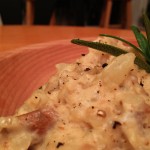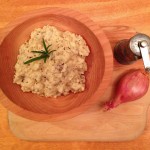This Meatless Monday, we feature potatoes, with growing, storage and prep tips, as well as recipes for Country Mashed Potatoes with Roasted Garlic and Rosemary and Potato Salad from Vermont Fresh: A Fruit and Vegetable Handbook.
Background
Potatoes were first cultivated many thousands of years ago in Chile and Peru and were taken back to Europe by Spanish explorers in the 15th century. Our name for potatoes probably comes from the word “batatas,” the native Caribbean word for sweet potatoes. Potatoes belong to the nightshade family, meaning that almost every part of the plant except their tubers (which we eat) is poisonous. Until explorers realized that potatoes had a high vitamin C content and therefore helped prevent scurvy, the somewhat bland root was mostly used by Europeans as a feed for livestock. President Thomas Jefferson is credited with introducing the now mainstream “French fry” to America when he first served them at a White House dinner. Once potatoes began to spread across the globe, they also became a very important crop. Because they are easily grown in a variety of climates and store well into the winter months, potatoes became a food staple in many places. Ireland came to depend heavily on the potato and, when potato blight struck in the 1840s and wiped out the crop, the ensuing famine took the lives of approximately a million people. Many countries still depend heavily on the potato for food. In America, we eat an average of well over a hundred pounds of potatoes (in various forms) per person per year.
Growing Tips
Potatoes are grown by planting “seed potatoes,” older potatoes that will sprout new plants. You can purchase certified seed potatoes or plant leftover potatoes that you may have around. Large potatoes can be cut, but each pieces needs to have at least 1-2 “eyes” (a dormant bud). Potatoes that have begun to sprout in storage are fine for planting. If you choose to cut them, do so a day early so the flesh can dry. Plant potatoes in late spring a foot apart in a trench about 6 inches deep. Leave at least 3 feet between trenches! Potatoes may rot in very heavy, damp soil. Once plants are several inches tall, hill soil up around them, then do so again about 3 weeks later. Dig up potatoes once tops have begun to die back.
Storage
Freshly dug potatoes should be “cured” in a dry, dark place for about a week, then should be stored in a cool, slightly moist area (away from onions). Root cellars are ideal for storing potatoes.
Nutritional Benefits
Potatoes are high in Vitamins C and B6 and have significant amounts of niacin, iodine, folic acid, copper, and magnesium. Much of a potato’s nutritional value is in its skin, so avoid peeling when possible or at least try to cook in the skin (like a baked potato).
Preparation
Cut any blemishes or green spots out of potatoes before using. They may be left unpeeled or peeled depending on the recipe and toughness of the skin. Potatoes are great baked, boiled, sautéed, mashed, and roasted.
Meatless Monday Recipe: Country Mashed Potatoes with Roasted Garlic and Rosemary
Dustin Smith, a volunteer baking, tasting and testing recipes out of the Vermont Fresh Handbook tried out this recipe. It’s a total customization of the mashed potatoes in the Handbook.
- Photo courtesy of Dustin Smith.
- Photo courtesy of Dustin Smith.
Serves 4 – 6 as a side course
Prep time is 45 minutes
Ingredients:
- 5 medium Potatoes (about 1.5 pounds)
- 1 bulb of Garlic
- 1 oz. of diced Shallot
- 10 leaves of fresh Rosemary
- 1 oz. of White Wine
- 8 oz. of Heavy Cream
- Salt and Pepper to taste
Procedure:
- Pre-heat oven to 400 degrees Fahrenheit.
- Wash Potatoes, cut into ½ in. cubes and boil in water.
- Peel garlic, toss in olive oil, season with salt and roast for 20 minutes or until lightly brown.
- Finely chop rosemary
- In a small pot add reaming olive oil and sauté the shallots until translucent. Remove the garlic from the oven, finely chop and add to the shallots. Add the rosemary to the shallots.
- Add the wine and reduce to 1/8. Add the cream to the wine shallot mixture and bring to a simmer.
- When fork tender, strain the liquid off the potatoes and return to the pot. Mash with a fork or a potato masher. Add the cream mixture to the potatoes and incorporate thoroughly.
Meatless Monday Recipe: Potato Salad
Serves 8
(adapted from Irma Rombauer et al: The Joy of Cooking)
Ingredients
- 2 pounds fresh potatoes of a boiling variety
- 3 eggs
- 1 cup celery, minced
- ½ cup sweet onion, minced
- ½ cup mayonnaise (or plain yogurt)
- 2 teaspoons mustard
- ½ cup chopped pickles with juice
- Salt, pepper, cayenne, paprika, and fresh parsley to taste
Instructions
- Bring a medium pot of water to a boil. Hard boil the eggs (first making sure that the shells are very clean).
- Meanwhile, scrub the skins of the potatoes and cut them into roughly 1 inch cubes. Once you remove the eggs from the water, boil the potatoes in the same pot until just tender.
- When the eggs are cool, chop them into small pieces.
- Drain potatoes and run briefly under cold water to chill them. Transfer to a large bowl.
- Add eggs and all remaining ingredients except paprika. Stir to combine, then sprinkle paprika over the top.
- Chill at least 2 hours before serving. Uneaten potato salad will store well in the refrigerator for several days.
To receive more recipes and tips on your favorite fruits and vegetables, download Vermont Fresh: A Fruit and Vegetable Handbook. We also need more volunteer home chefs for this project.
Vermont Foodbank fresh food initiatives would not be possible without your support. Please consider giving to the Vermont Foodbank today!



